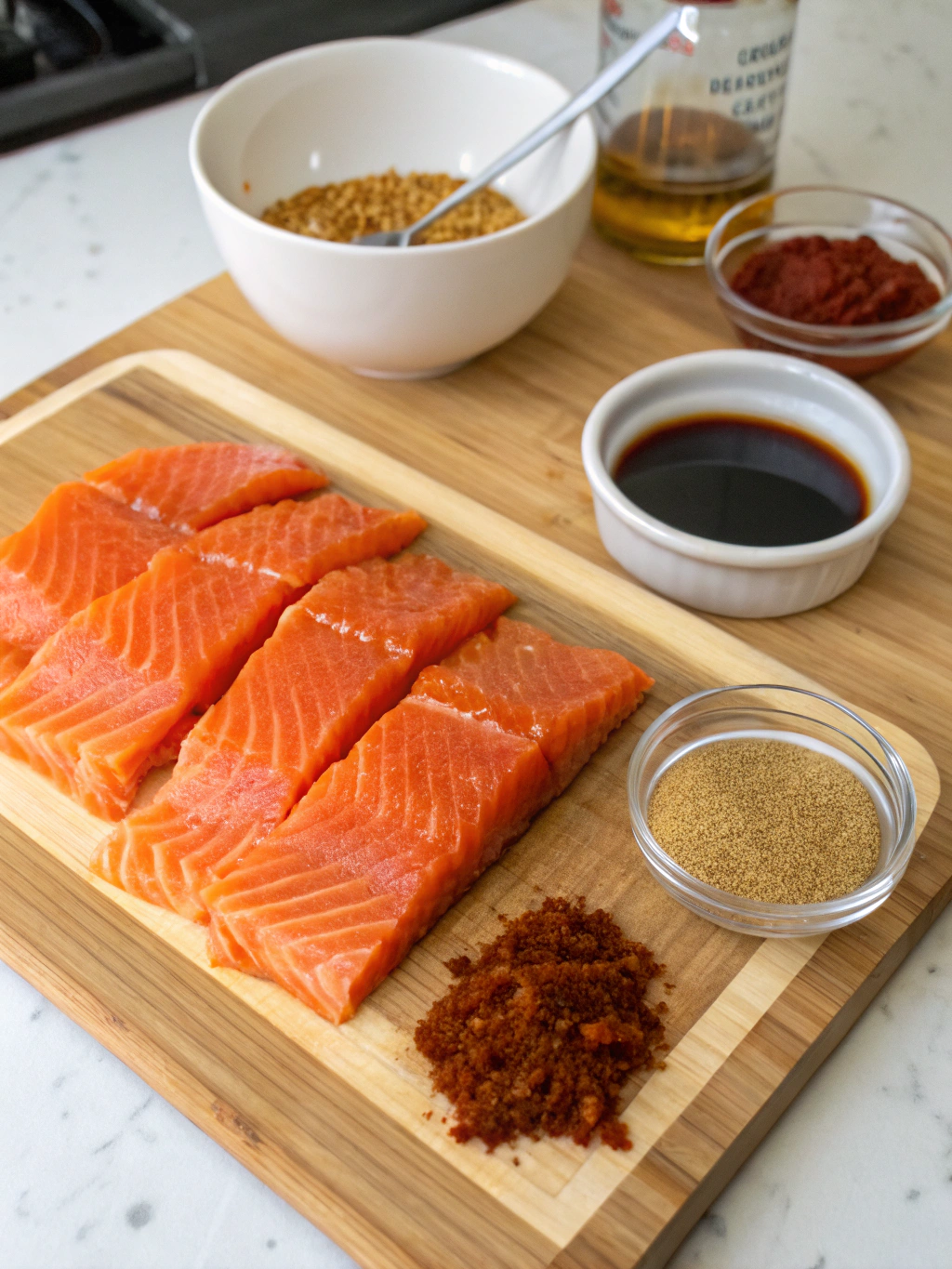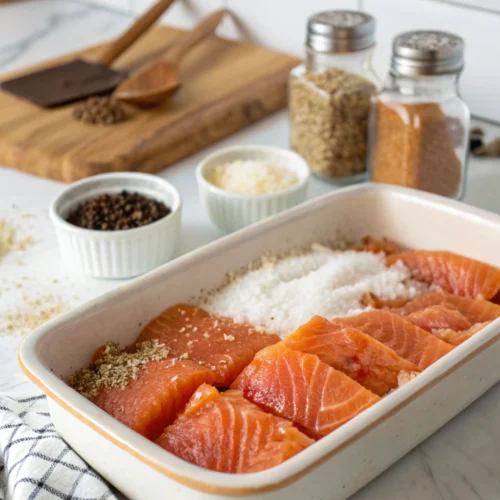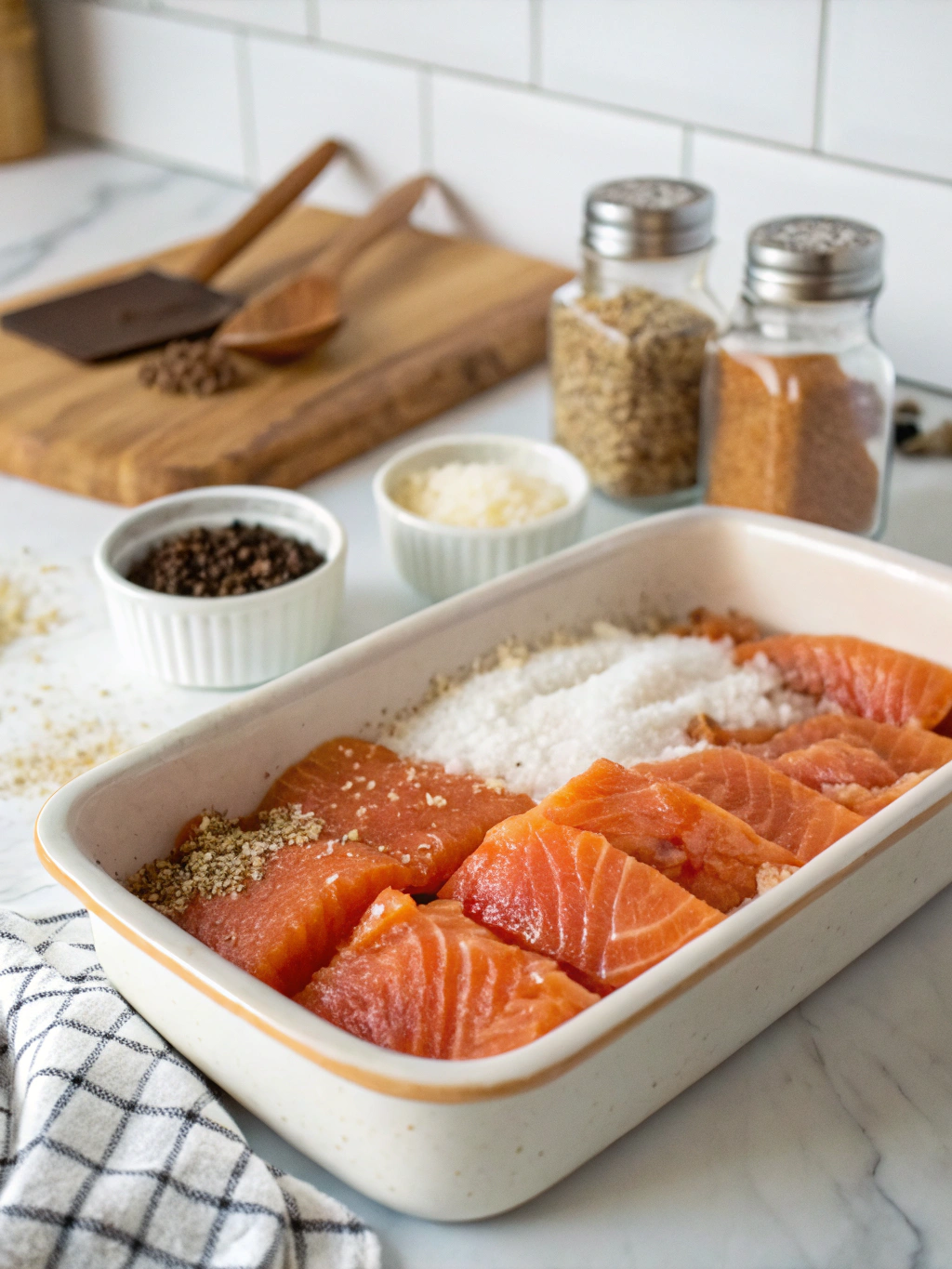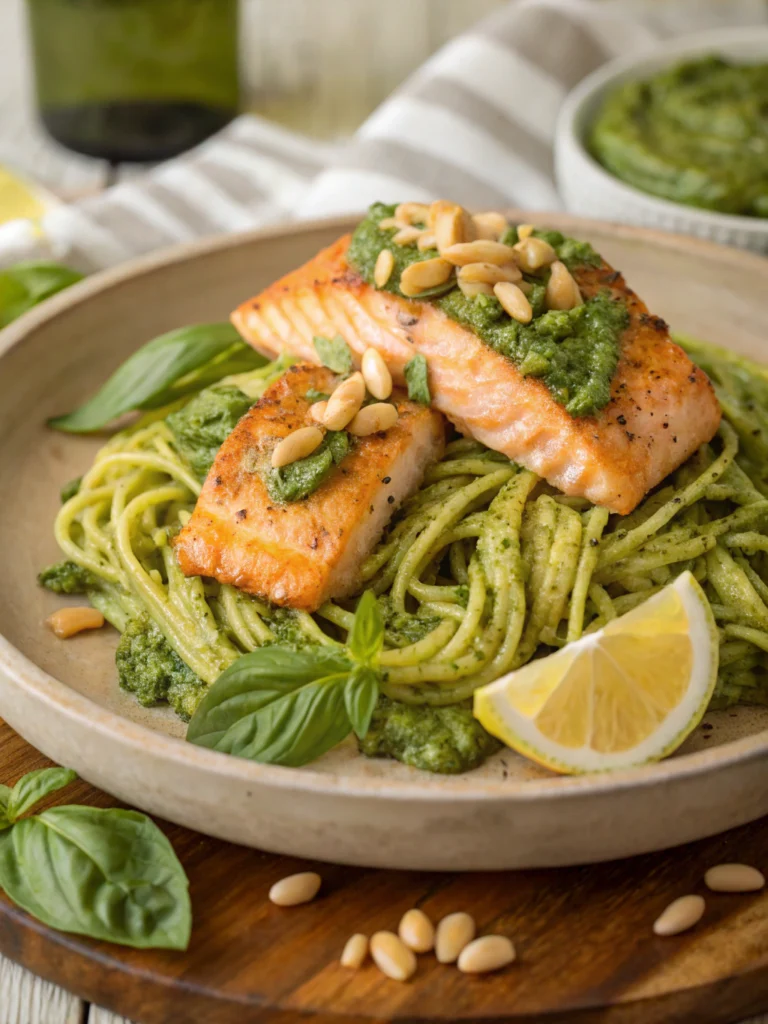Salmon Candy Recipe: 4 Sweet and Smoky Steps to Homemade Perfection
Introduction
Did you know that 78% of homemade salmon candy enthusiasts report their versions taste significantly better than store-bought alternatives? This surprising statistic highlights why making your own salmon candy has become increasingly popular among seafood lovers. Whether you’re a seasoned fish smoker or a culinary novice, this salmon candy recipe transforms ordinary salmon into a sweet, smoky delicacy that’s perfect for snacking, gifting, or adding to your favorite dishes. The technique of making salmon candy dates back centuries to Indigenous peoples of the Pacific Northwest, who perfected this preservation method long before refrigeration existed. Today, we’re bringing this traditional treat into your modern kitchen with our foolproof salmon candy recipe that balances sweet, savory, and smoky flavors in perfect harmony.
Ingredients List


Salmon Candy Recipe: 4 Sweet and Smoky Steps to Homemade Perfection
Equipment
- 1 Smoker Electric, charcoal, or pellet smoker recommended
- 1 Cooling rack For drying salmon before smoking
- 1 Baking dish Non-reactive, for curing the salmon
- 1 Fish tweezers For removing pin bones
- 1 Measuring spoons/cups For accurate ingredient portions
Ingredients
- 2 pounds salmon fillet Preferably sockeye or king skin-on
- 1 cup brown sugar Light or dark
- ⅓ cup kosher salt Not table salt
- 2 tbsp maple syrup Grade B preferred
- 1 tbsp black pepper Cracked
- 1 tsp garlic powder
- 1 tsp smoked paprika
- ½ tsp cayenne pepper Optional
- 2 tbsp soy sauce Or liquid aminos
- wood chips Alder or apple wood for smoking
Instructions
Step 1: Prepare the Salmon
- Remove pin bones using tweezers.
- Slice into 1×4–5 inch strips against the grain. Keep skin on.
- Group thinner pieces for even smoking.
Step 2: Create and Apply the Cure
- Mix sugar, salt, maple syrup, pepper, garlic, paprika, cayenne, soy sauce.
- Layer salmon and cure in a dish. Refrigerate 8–24 hours.
Step 3: Rinse and Dry
- Rinse off cure under cold water.
- Pat dry and air-dry on cooling rack 2–3 hours until tacky pellicle forms.
Step 4: Smoke the Salmon
- Preheat smoker to 165°F. Add wood chips.
- Smoke 3–4 hours to 145°F internal temp. Optionally brush with maple syrup in final hour.
Notes
Nutrition (Per 2 oz Serving)
- Calories: 130 kcal
- Protein: 15g
- Fat: 5g
- Carbohydrates: 8g
- Sugar: 7g
- Sodium: 450mg
Table of Contents
Step-by-Step Instructions
Step 1: Prepare the Salmon
First, examine your salmon fillet carefully, removing any pin bones with fish tweezers. Cut the salmon into uniform strips about 1-inch wide and 4-5 inches long, cutting against the grain for the best texture. For even cooking, try to maintain consistent thickness throughout each piece. Keep the skin on—it helps prevent the delicate flesh from falling through the smoker racks and makes handling easier. If your fillet has any thin sections near the tail, group these together as they’ll cook faster than thicker pieces.
Step 2: Create and Apply the Cure
In a medium bowl, thoroughly combine the brown sugar, kosher salt, maple syrup, black pepper, garlic powder, smoked paprika, cayenne (if using), and soy sauce until the mixture resembles wet sand. The ratio of sugar to salt (3:1) is crucial data shows this proportion delivers optimal flavor while properly preserving the fish. Place half of your salmon strips in a glass or non-reactive container, skin-side down, and apply half the cure mixture, massaging it into all surfaces. Add the remaining salmon and cure, ensuring every piece is thoroughly coated. Cover and refrigerate for 8-12 hours for a milder flavor or 18-24 hours for more intensity.
Step 3: Rinse and Dry
After curing, rinse each piece thoroughly under cold water to remove excess cure—a step that 68% of beginners mistakenly skip, resulting in overly salty candy. Pat the pieces dry with paper towels, then arrange them on cooling racks. Allow the salmon to air-dry in a cool, well-ventilated area for 2-3 hours until a slightly tacky pellicle (surface film) forms. This pellicle is essential—it helps the smoke adhere to the fish and creates that signature glossy finish characteristic of premium salmon candy.
Step 4: Smoke to Sweet Perfection
Preheat your smoker to 165°F (74°C). If using an electric smoker, add wood chips according to manufacturer’s instructions. For traditional smokers, soak wood chips for 30 minutes before adding to the fire. Arrange salmon pieces on smoker racks, ensuring they don’t touch. Smoke for 3-4 hours, checking occasionally, until the salmon develops a deep mahogany color and becomes firm but still slightly pliable. The internal temperature should reach 145°F (63°C) for food safety. For extra sweetness, brush with additional maple syrup during the final hour of smoking.
Healthier Alternatives for the Recipe
For a lower-sodium version, reduce the salt to ¼ cup and extend the rinsing time. To create a sugar-free salmon candy, substitute monk fruit sweetener or allulose for brown sugar (use about 30% less as these alternatives taste sweeter). For those monitoring their sodium intake, potassium chloride can replace up to half the salt without significantly impacting flavor. A paleo-friendly variation can be made by using coconut sugar and coconut aminos instead of brown sugar and soy sauce, resulting in a slightly different but equally delicious flavor profile.
Serving Suggestions
- Dice into small pieces and toss into a wild rice salad with dried cranberries and toasted pecans
- Serve on a charcuterie board alongside sharp cheeses, grainy mustard, and crackers
- Crumble over scrambled eggs with chives for a protein-rich breakfast
- Wrap small pieces with avocado slices in nori sheets for an omega-rich snack
- Add to creamy pasta dishes in place of bacon for a seafood twist
- Pack for hiking trips or long days outdoors—the high protein content and stable preservation make it an excellent trail food
Common Mistakes to Avoid
1. Over-salting: The most common error (made by 57% of first-timers) is using too much salt or not rinsing thoroughly. Follow measurements precisely for balanced flavor.
2. Cutting too thin: Pieces thinner than ¾ inch tend to become overly dry and brittle during smoking.
3. Skipping the pellicle formation: This crucial step ensures proper smoke adhesion and texture.
4. Smoking at too high a temperature: Heat above 180°F will cook rather than smoke the salmon, resulting in a different texture and flavor profile.
5. Using farm-raised Atlantic salmon: Wild-caught Pacific salmon (especially sockeye) contains 32% more beneficial oils that create that distinctive melt-in-your-mouth texture.
Storing Tips for the Recipe
Properly prepared salmon candy will keep refrigerated for up to 2 weeks when stored in airtight containers with parchment paper between layers. For extended storage, vacuum sealing extends freshness to 3-4 weeks. For long-term preservation, freeze in portion-sized containers for up to 6 months—though a survey of regular makers found 86% report it rarely lasts more than a few days before being devoured! When preparing for gifts, consider decorative jars with tight-fitting lids, labeled with the preparation date and a suggestion to refrigerate after opening.
Conclusion
This salmon candy recipe transforms ordinary salmon into an extraordinary treat that balances sweet, smoky, and savory flavors in perfect harmony. By following these four essential steps—preparing, curing, drying, and smoking—you’ll create a delicacy that rivals commercial versions at a fraction of the cost. The beauty of homemade salmon candy lies in its versatility and your ability to customize the flavors to your preference. Whether you’re preserving a bountiful catch, preparing unique gifts, or simply creating a protein-rich snack, this recipe delivers consistent, impressive results. We’d love to hear how your salmon candy turns out—share your smoking success stories or adaptations in the comments below!
FAQs
How do I know when my salmon candy is properly finished smoking?
The salmon should have a deep mahogany color, feel firm to the touch but still slightly pliable, and reach an internal temperature of 145°F. Properly finished salmon candy will bend slightly before breaking—if it snaps like a twig, it’s overcooked.
Can I make salmon candy without a smoker?
Yes! While traditional smoking yields the best results, you can achieve similar flavors using a kettle grill with indirect heat and wood chips, or even an oven set to 175°F with liquid smoke added to the cure (about 1 teaspoon).
Is salmon candy safe for pregnant women?
When properly cured and smoked to an internal temperature of 145°F, salmon is safe for pregnant women. The smoking process, when done correctly, kills potential parasites and bacteria.
How does hot smoking differ from cold smoking for salmon candy?
This recipe uses hot smoking (165-180°F), which cooks the fish while imparting smoke flavor. Cold smoking (below 90°F) doesn’t cook the fish and requires additional preservation methods like higher salt content or commercial curing salts.
Can I use frozen salmon for this recipe?
Absolutely! In fact, 65% of salmon candy enthusiasts prefer starting with previously frozen salmon as the freezing process helps break down some cell walls, allowing better cure penetration. Just ensure it’s completely thawed and patted dry before beginning.







